Star Trek Beyond
Written by Simon Pegg & Doug Jung
Directed by Justin Lin
Release date: July 22, 2016
Stardate: 2263.2
When Star Trek Beyond was released a year ago, I reviewed it for this site, and even did it in the rewatch format. My take on the movie hasn’t really changed, so I present that review once again to finish off the movie portion of the Original Series Rewatch. Next week, the TOS Rewatch will conclude with an overview of the ten films.
Captain’s log. Three years into the Enterprise’s five-year mission to explore strange new worlds, seek out new life and new civilizations, and boldly go where no one has gone before, Kirk is suffering a bit of burnout. Things have gotten almost “episodic,” he laments in his log. (Ahem.)
He’s trying to broker a peace between two warring alien races by bringing a gift from one race to the other. But the receivers of the gift respond with suspicion—their first comment is, “What’s wrong with it?” assuming that they’d only give something away if it was flawed and they didn’t want it anymore. It’s part of an ancient weapon that is no longer in use. The gift is refused and results in Kirk being attacked by a bunch of aliens (who are, luckily, very very small and therefore not much of a threat).
Kirk beams back to the ship, his uniform shirt torn, McCoy telling him he looks like crap. He has Spock place the ancient weapon in the ship’s archives. Later, he joins McCoy for a drink, with Kirk not feeling good about his birthday (it’s the day his father died, so he asks McCoy to continue to keep the actual day quiet).
The Enterprise stops for R&R at Yorktown, a giant starbase that is pretty much a big city in the middle of space. Uhura and Spock break up (though Spock refuses to let her give the necklace he gave her back), Sulu gets to spend time with his husband and daughter, and Spock meets up with some Vulcans who inform him that the Spock of the mainline timeline, who has been living on New Vulcan, has died. Kirk has a conversation with Commodore Paris about a possible promotion for him to vice admiral (which is a big jump in rank, but then this is the same guy who went from cadet to captain in six-and-a-half seconds, so whatever).
A ship appears out of nowhere emitting a distress call. Yorktown rescues the ship and its sole occupant, a woman named Kalara, who says her ship is lost in a nearby nebula. The Enterprise takes Kalara on board and navigates the nebula to find and rescue her ship—
—only to be ambushed by a vessel that seems at first to be a single ship, but turns out to be multiple small ones that attack like a swarm of bees, doing considerable damage to the ship, and then boarding it. Spock notes that the boarding party makes off with the ancient weapon from the archives. Kirk goes after the boarding party, and manages to get the weapon free and hide it with Ensign Syl, an alien whose cranial bones can retract and expand, allowing her to hide stuff on the back of her head.
Eventually, the bad guys—who never identify themselves—destroy the Enterprise. The crew who survive the attack get into the escape pods, but many of them are captured as well. Spock and McCoy manage to get inside one of the swarm ships and take out the crew, crash-landing it on the planet below, which is called Altamid.
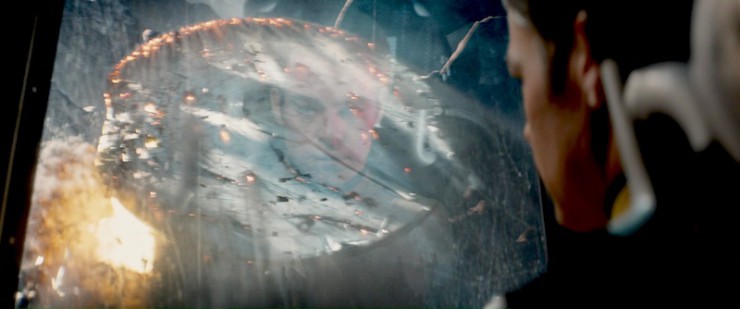
Kirk, Chekov, and Kalara all find each other, Kalara apologizing for leading them into an ambush, but it was the only way to safeguard her crew. Kirk says that he’s hidden the weapon somewhere in the saucer section, and the three of them trudge to where it crashed in order to retrieve it. Once they reach the spot where he says it’s hidden, Kalara communicates with Krall—the leader of the bad guys—to say they have it. Except Kirk was lying, and just wanted to get Kalara to contact Krall so Chekov could trace it. Kirk and Chekov barely escape the saucer section with their lives, as Kalara has called in the cavalry…
Sulu and Uhura are both captured by Krall, along with several other members of the crew. Krall has a device that he uses to drain the life out of people to prolong his own. As he uses it on the crew, his facial features change from almost lizard-like alien ones to less formed ones, almost as if he’s turning more human. Sulu and Uhura manage to break out of the cell they’re in and do some covert surveillance, only to discover that Krall has managed to tune into Starfleet communications frequencies, giving him access to the logs of Yorktown as well as any ship that has come to that port, including the Enterprise, which is how he knew to steal the weapon.
Spock is badly injured in the crash landing, and McCoy is forced to perform field medicine to at least stabilize him. Spock informs McCoy that the other Spock has died, and also that he is thinking about leaving Starfleet to help with the establishment of New Vulcan. This turns out to be a big part of why he and Uhura split up. Spock hasn’t told Kirk about this yet. (But that’s okay—Kirk hasn’t told anyone about his desire for a promotion to a desk job, either.)
Scotty was cut off from the escape pods, but managed to escape inside a photon torpedo. He clambers out of the torpedo before it falls over a cliff, only to find himself ambushed. He, in turn, is saved by a young woman named Jaylah. Jaylah was on another ship that was destroyed by Krall’s hive ships, its crew used as slave labor and as “food” for Krall. Jaylah managed to escape, though her father was killed by Krall’s lieutenant Manas, and she took refuge in one of the ships that crashed on the planet—which turns out to be a Starfleet vessel, the U.S.S. Franklin, which had been lost a century earlier. Scotty is able to retune the old transporter to work on humans (it was only meant for cargo), and manages to beam Spock and McCoy to the Franklin—and just in time, as Krall’s people just found the pair of them. Kirk and Chekov also find the ship on their own (by triggering one of Jaylah’s many booby traps).
Krall threatens Sulu’s life, which gets Syl to reveal that she has the weapon. Krall then takes Uhura and Syl out of the cell to demonstrate the weapon—which, to Uhura’s disgust, he does on Syl, who is basically cut into pieces on an atomic level.
Using the Franklin‘s medical equipment, McCoy is able to heal Spock a bit more, though he’s still pretty ragged. Chekov is able to verify that the prisoners are in the same place as Krall, and so they need to mount a rescue. Jaylah is reluctant to do so, knowing how dangerous it is, but Scotty and Kirk talk her into it, mostly by assuring her that they’ll have her back.
One of the Franklin crew had a motorcycle on board, and Kirk rides that as a distraction while Jaylah, Spock, and McCoy free the crew. Spock even manages to save Uhura—kind of. In truth, she escaped on her own, and then rescued Spock from being ambushed. But whatever works.
To Jaylah’s relief, Kirk risks life and limb to save her life when he very easily could have left her behind.
However, Sulu and Uhura reveal that Krall is already implementing his plan: to attack Yorktown. Even as his hive ships take off, Sulu manages to get Franklin into the air and out into space. Spock and McCoy fly one of the hive ships as a Trojan horse within the hive, while Uhura hits on the notion of using VHF radio to disrupt the instant communication among the hive ships.
In addition, Uhura realizes that one of the logs of the Franklin has someone with Krall’s voice: it’s Captain Balthasar Edison, a former MACO in service of the United Earth, later made a captain of a starship when the Federation was formed. To everyone’s shock, they realize that Krall is, in fact, Edison. The Franklin crashed on Altamid, and Edison used the technology there to prolong his life at the expense of others he has forced to crash here. He blames the Federation for abandoning him, and also for putting him in charge of a ship on a peaceful mission when he was a soldier.
While the VHF disruption is successful in destroying most of the hive ships, Krall himself still is able to board Yorktown. He brings the weapon to the air supply station in order to spread it to the entire base. While Scotty and Jaylah try to shut down the station remotely—a complicated process—Kirk tries to stop Krall directly, eventually succeeding after a lengthy fistfight. Krall himself winds up being the only other casualty, besides Syl, of the weapon.
The crew recovers on Yorktown, even celebrating Kirk’s birthday (and also making a toast to absent friends) while a new Enterprise—the NCC-1701-A—is built, with Kirk once again taking command, having decided against going for the admiral’s position.
Can’t we just reverse the polarity? While it is very difficult to shut down Yorktown’s air supply for obvious reasons, it’s remarkably easy to physically enter it. Also the nebula that Altamid is in sure looks like a dense asteroid field…
Fascinating. Spock and Uhura’s relationship seems to be over at the beginning, as Spock has withdrawn even more while he considers moving to New Vulcan. But by the end of the film—and in particular seeing a picture of the crew from the other timeline still being together into middle age—he decides to stick around and possibly rekindle his romance with Uhura. (We’ll find out next film, I guess…)
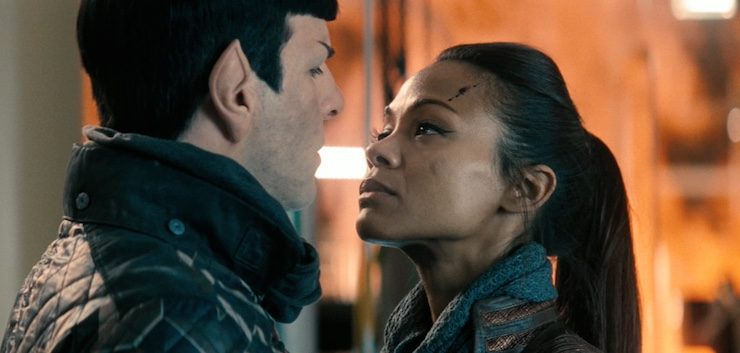
I’m a doctor not an escalator. McCoy manages to cauterize Spock’s wound with almost no actual medical equipment. Because he’s just that awesome. He also flies one of the hive ships by the seat of his pants, which enables him to rescue Kirk at the end.
Ahead warp one, aye. Sulu is able to make the Franklin—despite never having been built for takeoff in a gravity well—take off. Because he’s just that awesome.
After all the pre-movie fuss about it, the scene that shows him with his husband and daughter is all of ten seconds, and just shows that he’s visiting family when he gets to Yorktown, one of several ways the crew takes shore leave. It’s actually a touching moment, one that adds texture to the scene, and anyone who says it’s gratuitous is showing their bigotry, because if he met up with and kissed a woman, no one would even consider calling it that. It’s also called back to later by the look of horror on John Cho’s face when they realize that Krall is targeting Yorktown.
(Also, the argument that the characters’ sexuality shouldn’t be shoved in our faces in a Star Trek story—which I’ve seen multiple times around the internet—is nonsense. Various characters’ heterosexuality is shoved in our faces repeatedly throughout the original series. Just looking at the first few episodes: “The Cage” is about forcing Pike to mate with Vina; “The Man Trap” is about McCoy’s old girlfriend, and the salt vampire appears as various people’s sexual desires; “Mudd’s Women” gives us three women who drive men mad with sexual desire; “Charlie X” gives us Charlie’s crush on Rand; and on and on and on. If you don’t want to see characters’ sexuality, you shouldn’t be watching Star Trek.)
It is a Russian invention. In what is sadly Anton Yelchin’s last appearance as Chekov, he doesn’t get that much to do as such, but he is a steady presence, serving as Kirk’s sidekick for much of the film and doing lots of tech work to move the plot along.
He also doesn’t keep vodka in his quarters, to McCoy and Kirk’s shock, but he does insist that Scotch is a Russian invention.
Hailing frequencies open. Uhura is the one who figures out who Krall really is, mostly by recognizing his voice on the Franklin footage. She also implements the VHF disruption plan, with help from Scotty and Jaylah.
I cannot change the laws of physics! Scotty pretty much saves the entire day here, since he’s the one who gets the Franklin up and running, which is what enables our heroes to stand any kind of chance. His banter with Jaylah is epic, also.
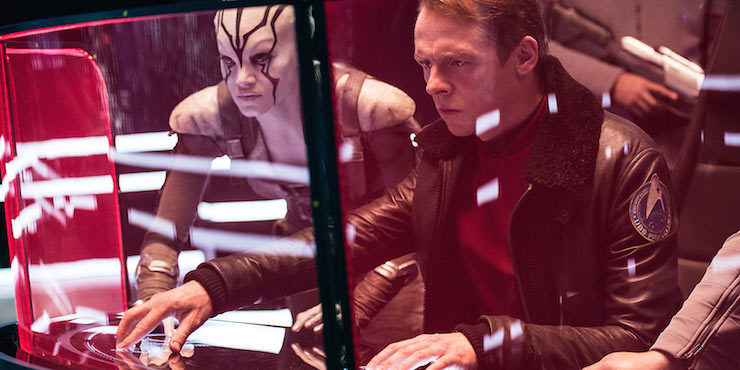
Go put on a red shirt. A big chunk of the crew is killed in the initial attack on the Enterprise, with more killed on Altamid. In addition, Syl is killed to demonstrate how awful the weapon is, and to horrify Uhura—and then she is utterly forgotten, and never even mentioned again. When Spock frees the prisoners, Sulu says Uhura is with Krall, without even mentioning Syl, even though they were taken together and Sulu has no way of knowing that Syl is dead.
No sex, please, we’re Starfleet. Spock says they can track Uhura via the necklace he gave her, as it emits a unique radiation signature. This prompts McCoy to be appalled at the notion that he gave his girlfriend a radioactive necklace. Spock assures him that the levels are harmless, but easily detectable. Undaunted, McCoy is appalled at the notion that he gave his girlfriend a tracking device. After an uncomfortable pause, Spock says that was not his intention. McCoy remains appalled.
Channel open. “I’d rather die saving lives than live with ending them. That’s the world I was born into.”
Kirk explaining Roddenberry to Krall.
Welcome aboard. A smaller cast in this one, which works to good effect. Greg Grunberg and Shohreh Aghdashloo play Yorktown crew—the former is Commander Finnegan, the latter is Commodore Paris. Lydia Wilson is effective as the double-crossing Kalara, doing superlative work with facial expressions under the alien makeup, while Melissa Roxburgh does a fine job as the tragically short-lived Syl.
Sofia Boutella is a pure delight as Jaylah, a snarky presence that adds a lot of niftiness to the film. (The movie ends with Jaylah’s application to Starfleet Academy being approved. It is my hope that, with Anton Yelchin’s death, the next film will have Chekov transferred to another ship—the Reliant would make the most sense—with Jaylah assigned to the ship as the new navigator after graduating.)
And then we have the great Idris Elba as Krall, who does the best he can with an unfortunately underwritten role. His best moments are at the climax when he mostly looks human again, because you can see the anguish and the anger on his face when he confronts Kirk, bitter and resentful of the Federation for forcing him into a peaceful mission and then abandoning him when the Franklin was lost.

Trivial matters: The film is dedicated to the memory of both Leonard Nimoy (“In loving memory of Leonard Nimoy”) and Anton Yelchin (“For Anton”).
Kirk’s log says that they’re in Day 966 of their five-year mission, the specific number being a reference to the date of Trek‘s premiere in September 1966.
Yorktown was the original name Gene Roddenberry had for the ship in his earliest drafts of Star Trek, later changed to Enterprise.
Jaylah was inspired by Jennifer Lawrence’s character Ree in Winter’s Bone. The character name wound up being a corruption of Lawrence’s name.
The Enterprise saucer can separate, a feature that was mentioned once on the original series (in “The Apple“) as well as in the behind-the-scenes material printed in The Making of Star Trek by Stephen Whitfield & Gene Roddenberry, but never seen on screen until TNG, where it was seen in “Encounter at Farpoint,” “The Arsenal of Freedom,” “The Best of Both Worlds Part II,” and Star Trek Generations.
Scotty refers to a “giant green hand” as one of the possible fates of the Franklin, a reference to “Who Mourns for Adonais?” He also mentions that he transported Spock and McCoy separately to avoid the risk of “splicing” them together, something that happened with Tuvok and Neelix in the Voyager episode “Tuvix.”
Kirk grumbles about how his uniform shirt has been torn again, something that happened with sufficient regularity on the original series that it was actually parodied in the movie Galaxy Quest.
Several references to Enterprise in this one: the Franklin is a ship of a similar style to that of the NX-01, the uniform Spock puts on after his own is ripped to shreds is similar to those worn by the cast of that show, and Krall recalls fighting against the Xindi (from the show’s third season) as well as the Romulans (actually from “Balance of Terror,” but Enterprise would have done that war had it made it to a fifth season) as a MACO (Military Assault Command Operations, established in “The Xindi”).
Kirk’s father died the day his son was born in the 2009 film.
Commodore Paris is likely meant to be an ancestor of the Paris family seen in Voyager, including main character Tom and his father Owen, an admiral in Starfleet.
Sulu’s daughter is presumably named Demora, since Generations established that Sulu had a daughter by that name.
Chekov’s explanation that Scotch was invented by a little old lady in Russia is a callback to a similar line he had in “The Trouble with Tribbles.”
A member of the Franklin crew liked twentieth-century hip-hop, as the play list includes Public Enemy’s “Fight the Power” and the Beastie Boys’ “Sabotage.” The latter song was also being played by Kirk as a young boy when he was stopped for speeding in the 2009 film.
The picture of the crew from the mainline timeline that Spock looks at among his counterpart’s effects is a publicity still from Star Trek V: The Final Frontier.
In the mainline timeline, when a new Enterprise was constructed after the original was destroyed, it was also designated NCC-1701-A.
At one point, Kirk interrupts Spock and says, “Skip to the end,” a phrase used repeatedly on Simon Pegg’s TV show Spaced.
To boldly go. “Well, that’s just typical…” It’s a huge relief to, for the first time in twenty years, get a Star Trek film that works as a Trek film, as an action film, and as a film in general. It’s not great on any of those levels, but I’ve said before that Trek is not built to be a franchise made of blockbuster movies. Trek is at its best with smaller stories that one tells on television—the very types of stories that are blown off in a log entry in this movie as being “episodic.”
With that caveat in mind, though, this is the first Trek film since First Contact in 1996 that can actually be called good.
What’s best is that the script follows a logical progression, and is mercifully free of the howlers of the last two Bad Robot films. The plot commences with that old Trek standby, the Enterprise responding to a distress call, in this case Kalara’s cry for help at Yorktown, with the Enterprise going to Altamid intending to rescue her crew. That Kalara was using their compassion against them doesn’t negate the importance of that action.
The middle part of the film pulls the old trick of separating the crew, thus giving them all a chance to shine. This was my favorite part, honestly, as the pairings all worked quite well. The weakest was Uhura and Sulu, mainly because it didn’t do much with either character, just moved plot pieces around. It was also the ideal time to do the reveal about Krall instead of saving it for later in the film—more on that in a bit…
Kirk and Chekov teaming up was mostly useful for showing us how Chris Pine’s Kirk has matured. The Jim Kirk of the 2009 film was a punk and the Jim Kirk of Into Darkness still had way too many punk tendencies. But the Jim Kirk of Beyond is, for the first time, the captain. He’s the leader, the one who makes decisions, the one who jumps in with both feet, but also looks out for his people. I would never have credited Kirk with being clever enough in either of the two previous films to pull off the trick he pulled on Kalara, but it was utterly convincing here.
It’s not surprising that Scotty gets so much to do here, partly because Simon Pegg is a great actor whose portrayal of Scotty was one of the high points of Into Darkness, and partly because Pegg cowrote the script. But his banter with Jaylah is tremendous fun.
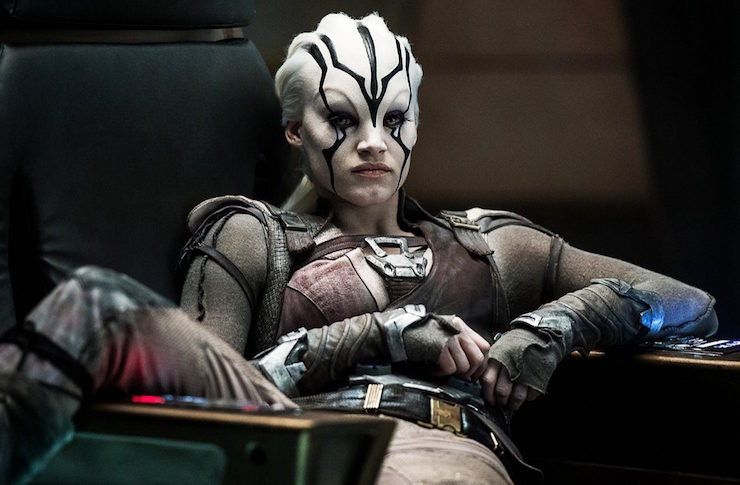
However, the best parts of the entire film are the scenes with Spock and McCoy. Zachary Quinto and Karl Urban have both done a great job filling the shoes of Leonard Nimoy and DeForest Kelley, but Urban has been criminally underused to date. This film finally rectifies that, and gives us the Spock-McCoy banter that was one of the best parts of the original series and their followup movies. One of the things that gave me hope for this movie in the trailers was the scene where McCoy says, “At least I won’t die alone,” then Spock is beamed away, and McCoy grumbles, “Well, that’s just typical,” and I’m pleased to report that that’s just the tip of the iceberg. In particular, the horseshit conversation is the highlight of the entire film.
There are other great moments here, from Kirk and McCoy drinking (the Roddenberry hallmark of the captain sharing a drink with his doctor to discuss psychological issues, which goes all the way back to “The Cage“) some of Chekov’s purloined booze (“I thought he’d be a vodka man”), to Spock going through his counterpart’s effects, to the best depiction of the universal translator yet, to the use of hip-hop (“I like the beats and the shouting”) to help save the day, the best use of modern music in Trek since “Magic Carpet Ride” in First Contact, to “you kiddin’ me, sir?”
Having said that, the movie is far from flawless. Kirk’s and Spock’s character arcs are weak and poorly defined. The considering-a-desk-job thing and the resigning-Starfleet-because-things-are-weird thing have been done to death in Trek (The Motion Picture, “Emissary,” “The Way of the Warrior,” “Home,” etc.), and this adds nothing to it. What, exactly, Krall has been doing on Altamid for a century is left maddeningly vague. Jaylah’s conflict with Manas is also weak and poorly defined, and doesn’t even get good closure.
But worst of all is that we don’t find out who Krall really is until way too late in the movie for it to have a proper impact. The theme of the soldier who can’t handle peace is a good one in the abstract, and Idris Elba manages to sell it in his conversations with Kirk in the Yorktown air supply station, but this was a reveal we should’ve gotten when Uhura and Sulu confronted Krall in the prison, not when the movie was two-thirds done.
Still, this is the first of the Bad Robot films that feels like a Star Trek movie, which is the best possible 50th birthday present for the franchise.
Warp factor rating: 6
Keith R.A. DeCandido will be at Florida SuperCon in Fort Lauderdale this coming weekend, spending most of his time at the Bard’s Tower booth in the autograph area. Other guests include Star Trek actors LeVar Burton, John deLancie, Armin Shimerman, and Tony Todd; Doctor Who actors Peter Capaldi, Karen Gillan, and John Barrowman; fellow authors Peter David and Kevin J. Anderson; and tons and tons more. Keith’s full schedule is here.










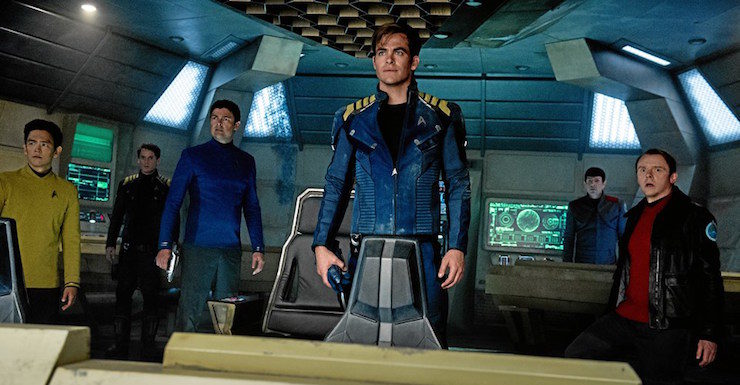
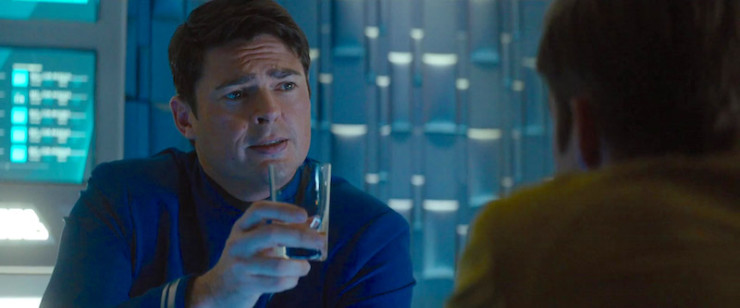

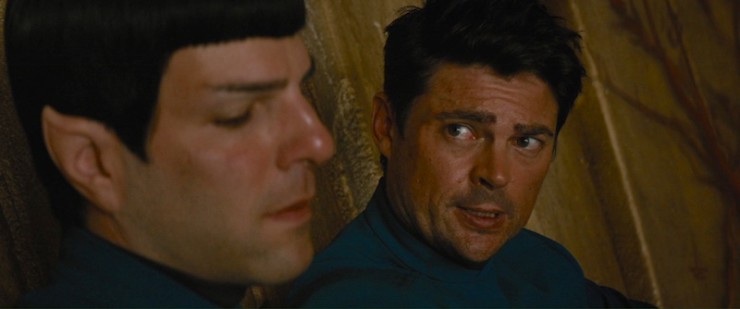
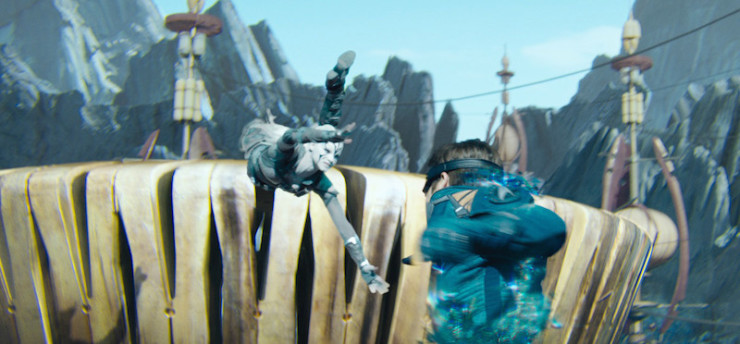
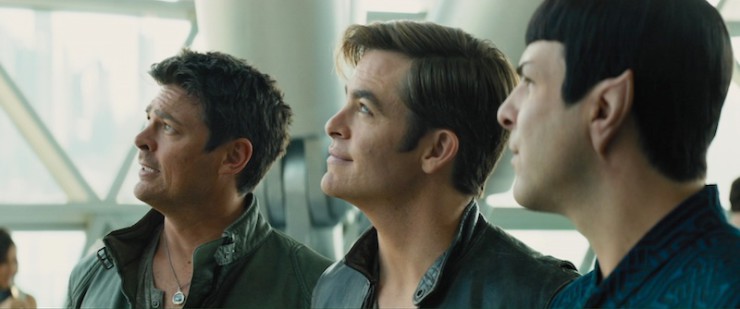
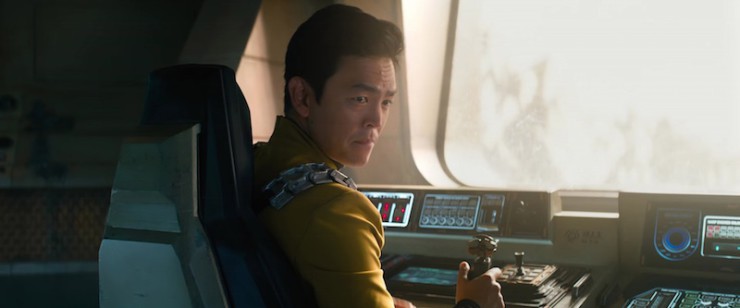
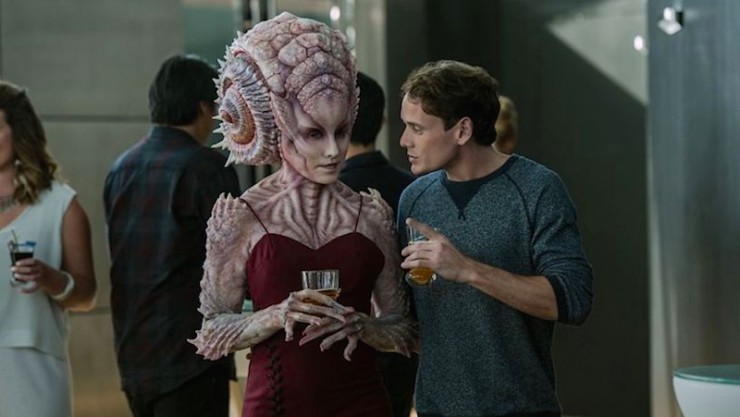
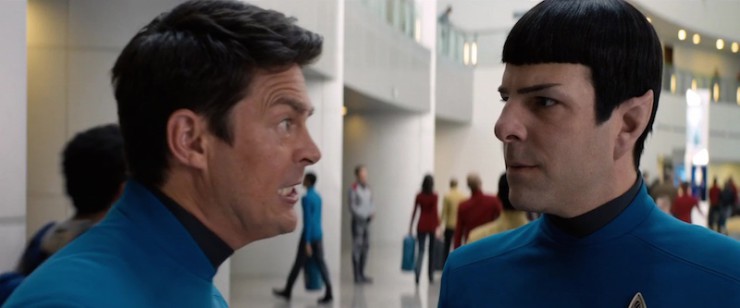
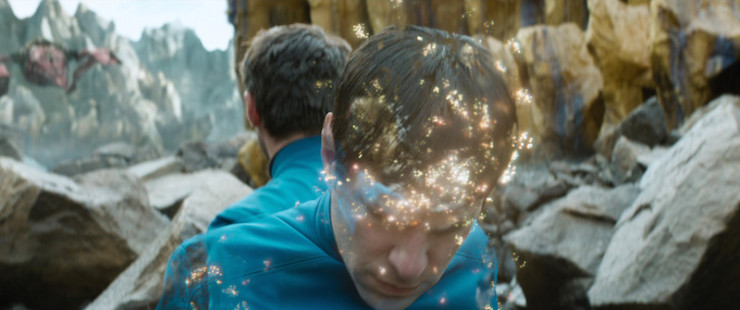
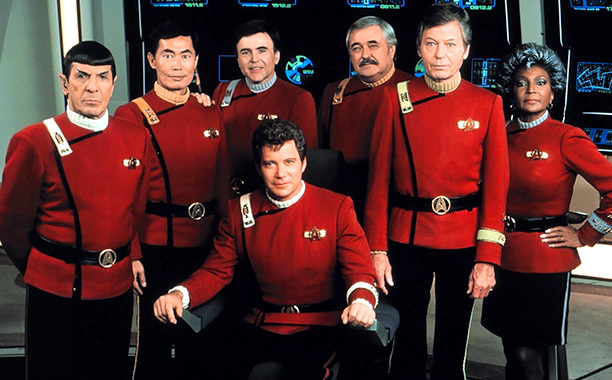
This is the first JJverse movie I enjoyed, probably because of the lack of JJ. It is a shame it didn’t do better, but the audience was scared off by how bad the previous movie was and was skittish on returning to the franchise; which is a crying shame.
My only problems are the recurring use of the chosen one trope for Kirk (and the use of the name Yorktown for the base, surely a more culturally neutral name ought to have been selected?) with him supposedly being ready for a jump to admiralty ranks at the start despite not showing the dedication that such a job would need. It is a total slacker kid move to say he got bored in space and now wants to be a space boss. Millennial kid problems there, Jimmy me lad.
Also at the end, despite getting his crew massacred and ship destroyed in an even worse rookie move than his Original Universe counterpart did in WoK, he is rewarded with a new Enterprise which is given the “A” prefix which was supposedly a reward for the Original Enterprise being sole survivor of its five year mission. NuKirk should have been facing a court martial for that. Of course that would make getting a new Enterprise for the next movie a real problem, so I’m chalking that up to a difficult writing problem.
It is just NuKirk doesn’t seem to be earning the things he gets. It is shallow achievement instead of depth of character. There are touches, here and there, which shows Pine can act the part of a weary and seasoned captain which he is supposed to be, but too often the direction and script have him keep on defaulting to frat-bro!Kirk and that isn’t good. It is like they are scared to show him being an adult in much of the movie.
Beyond is a better movie than its two predecessors, low bar to clear, and shows promise, but it just doesn’t quite manage to hit the high notes it thinks it does.
What I will say about this film is that of the three alternate timeline movies it does the best job of capturing the feel of the camaraderie that the crew had in the original movies. That being said I think of the three movies its the weakest by far. Keith I honestly don’t understand how you can call yourself a Trek fan. I had a look back all of your reviews and the highest review you gave was a 6 (presumably out of 10?) Most of the other films received a 2 or 3. Maybe you prefer the TV series to the movies. I just honestly don’t understand your reviews. The only Trek film I think is awful is Nemesis. I realize that all of this is highly subjective but the highest review is a 6? And that for Wrath of Khan (a couple others too I think). Really???
Ensign Syl – very convenient just happening to have an alien around with a secret pocket in her head. Geez.
Kalara – still don’t get why Kirk didn’t shoot her lying *ss as soon as she called Krall. (yeah, I know, blah blah blah her crew. Still doesn’t clear her of her role in the deaths of lord only knows how many Star Fleet personnel)
Liked this movie a lot more than ID, but you can only fill a movie with so many in-jokes and one-liners before it gets tedious. They really need to think hard about that in the next one.
Actually, this was, IMHO, the worst of the “new crew” movies. It failed utterly as an action movie…Kirk continually riding around on his motorcycle with the hologram to “distract” the bad guys was particularly weak. Not being able to, you know, call down and have security meet what’s-his-face at the water supply made no sense; only Kirk and his manliness can personally stop this threat by getting his shirt ripped again. Yes, let’s blow up the Enterprise…again. Yawn. Let’s save the day by blasting hip-hop music into the air-waves…awwwww(puke!, puke!).
The character arcs in the film are very half-baked, and while the Spoke-McCoy banter was nice, all of the character arcs felt limp or half-baked, especially the villain. Are all those henchmen his former crew? People he ‘recruited’ over the years? Where did he get this hive technology and the face-altering, life-extending tech? How is he hacking into all the Star Fleet computers so easily without Star Fleet knowing? Convenient bad guy super powers? You decide! And if he had been there so long, why is he waiting until now to start messing with Star Fleet? Why not when they where building the Yorktown in his neighborhood? Yes, he wanted the McGuffin weapon and all, but he hardly seemed to need it, if not for the hip, hop intervention, it seems his attacking swarm would have destroyed the space station. This could have been an interesting villain, maybe with a prologue of things going south for the Franklin and its captain to set things up, but it was really paint-by-numbers villainy.
In fact, the whole thing came off as a weak paint-by-numbers and role your eyes Action Movie with weak characterizations and plot.
Mark Magee: I have a very easy time calling myself a Trek fan, since I’ve been watching the show almost literally since birth, and have enjoyed a great deal of it in various incarnations.
But I also have been very upfront about the fact that I don’t think Trek works particularly well in the blockbuster Hollywood movie mode, because that subgenre doesn’t lend itself to the level of character development and philosophical underpinings that are Trek‘s hallmark. My list of top twenty-five Trek screen stories would include at least one episode from each of the five TV series, but no movie would crack the list. None of the movies deserve to even be in the same conversation as “The City on the Edge of Forever,” “Amok Time,” “The Best of Both Worlds,” “Yesterday’s Enterprise,” “The Inner Light,” “The Visitor,” “Tacking Into the Wind,” “Far Beyond the Stars,” “In the Pale Moonlight,” “Jetrel,” “Year of Hell,” “Judgment,” or “Demons”/”Terra Prime.”
—Keith R.A. DeCandido
This movie was a breath of fresh air after Into Darkness, and much more worthy of the name Star Trek than the 2009 outing. It works like a TV episode…. an excellent one? No, but at least a good one. I hope Lin, Jung, and Pegg are in charge of the next Kelvin film.
I can’t believe you liked this movie more than Into Darkness! To each his own I guess.
I will say the VHF radio wave maneuver at the end was the most preposterous thing in any of the Star Trek movies, and was so beyond believability or suspension of disbelief, that I think of it as a far bigger plot hole than anything you rightfully pointed out with respect to those in the previous film.
After Into Darkness, I didn’t bother to see this movie. Still on the fence. But it sounds better than some of the others from the reboot.
I agree, this was a breath of fresh air after the dreary Into Darkness. I especially liked the more contemplative moments where you see characters simply thinking. There’s the scene early in the movie where the Enterprise is crossing the nebula/asteroid field, Kirk looks over to Spock, and both of them appear to have other things on their minds. A nice character moment with dark moody lighting. It was very Original Series. More of that please.
(Just what is the word on a fourth movie? I haven’t heard anything in quite awhile. Has Paramount put Trek on the back burner for the foreseeable future?)
@9: Last I heard, It was still in development process, set for a 2019 release date. And there were supposed rumors of an attempt at bringing back Chris Hemsworth as Kirk’s father as part of the upcoming story. But given the upcoming release of Discovery, I wouldn’t put it past Paramount to wait and see how that fares with viewers before committing to the next film.